Movie Review: Roald Dahl’s The Witches

Though Roald Dahl’s The Witches was adapted into a feature-length film in 1989, the famed author was heard to have greatly hated the direction the adaptation took (word was, he even found fault with the 1971 adaptation of his book, Charlie and the Chocolate Factory). One has to wonder if director Robert Zemeckis (Back to the Future, Who Framed Roger Rabbit) breathed a sigh of relief, knowing that the author wouldn’t be slipping him notes on this latest adaptation.
Moving the story’s setting to the American south in the late 60’s, the film’s lead boy (played by Jahzir Bruno) ends up in the care of his grandmother (Octavia Spencer) after losing his parents. When the boy encounters a strange woman one day, grandma claims he encountered a witch, and takes him into hiding at a fancy resort hotel…not realizing it is the planned meeting place of numerous witches, and their leader: The Grand High Witch (Anne Hathaway).
Bruno plays his role of the unnamed lead pretty well, showing a traumatized young boy who is coaxed back to life by his Grandma, but then must deal with a new problem in his life. Unfortunately, there seems to be a strange difference in attitude and energy once he becomes a mouse, as if he’s gotten an adrenaline rush from the change. Maybe if the film had shown him at these same energy levels as a boy, it might have worked better for me.
Octavia Spencer was one of the highlights of Pixar’s Onward earlier this year, and she does well playing a grandma that can be caring, but also doesn’t put up with much guff. There also is a strange malady the story afflicts her with that never feels like we fully get a payoff on, let alone her being referred to as a healer almost as an afterthought.
One role that I think many will be most curious about, is the latest iteration of The Grand High Witch. Unlike the more serious take in the 1989 adaptation, Hathaway’s characterization ping-pongs from creepy to campy at times, with enhancements that rely a little too heavily on Zemeckis’ computer-generated imagery. Even so, there are some images shown that I could see terrifying little kids (in much the same way Zemeckis terrorized us with Judge Doom in Roger Rabbit), let-alone some close-up shots that I feel were indicative of a possible 3-D theatrical release before COVID-19 happened.
The screenplay crafts a much different world than the book, one where the main target of witches are out-of-the-way minority children, while under the guise of wealthy, beautiful women. It feels like the story could have explored this social topic a little further, but the film seems to be in a rush to get us to the more memorable parts of the story. Throughout the film, “the bones” of Dahl’s story are pretty much intact, and I even saw a few things from the book that surprised me.
One of the things that the viewer may find rather annoying, is that the story is largely told with a narrator. It almost feels like the story was forced down this path to help along younger viewers, but it is probably the most “overkill” thing in the entire film.
There also is an over-reliance of computer-generated effects at times that can take the audience out of some scenes (did we need a CG cat, Bob?), let alone some effects scenes that feel like they needed a little more time to be perfected. It does seem odd that we have what seems like a real-looking mouse, and yet when the lead is turned into a mouse, he becomes a bit more, “cartoony” in appearance.
Much like with Charlie and the Chocolate Factory, one can just imagine a bunch of “1989 vs 2020” debates regarding which of the adaptations of this work is better. While I had my trepidations about Zemeckis making this film (his 2018 release Welcome to Marwen left me very nervous about his future), I was surprised by how entertaining it was for most of the time. It does manage to stick to the basics of the story, while never straying too far. And for those who are fans of Dahl’s work, don’t be surprised if you find a few little ‘easter eggs’ hidden within the film.
Even with the film being passable however, I still will wonder what the film could have been like, when Guillermo Del Toro (Hellboy, The Shape of Water) was attached to direct it as a stop-motion project over a decade ago.
Final Grade: B-
__________
Movie Review: Ready Player One

Rated PG-13 for sequences of sci-fi action violence, bloody images, some suggestive material, partial nudity and language
While I had known about Ernie Cline’s debut novel Ready Player One for awhile, it wasn’t until hearing the author’s concept for the book, did I become intrigued: what if Willy Wonka was a video game designer, and he held his Golden Ticket Contest, inside his greatest video game creation?
That led me to seek out the book, and, upon hearing that Steven Spielberg was going to be adapting it, I was pretty much onboard for the bearded one’s latest film.
__________
In the year 2045, much of the world is in economic ruin. To combat their dreary existences, many people have escaped into the lifelike-yet-fanciful virtual world called The Oasis. Created by legendary gamemaker James Haliday (Mark Rylance), the late genius secretly created a contest within his borderless world…a contest that not only promises massive wealth, but total control of his greatest creation!
The film follows Wade Watts (Tye Sheridan), who along with his friends, attempts to solve the riddles and puzzles Haliday left behind.

Wade Watts (Tye Sheridan)
However, the evil conglomerate known as IOI (Innovative Online Industries), is hoping to turn the free-to-roam world into a pay-to-play empire. Led by the business-minded Nolan Sorrento (Ben Mendelsohn), the company will do everything it can, to win.
__________
While several people I know were fully ensconced in the world that Ernie Cline had written, I will admit his novel didn’t fully grab my attention. With the film’s screenplay however, there has definitely been some fine-tuning. With help from screenwriter Zak Penn (who wrote the story for Last Action Hero), there is a small toning down regarding the video game references, and a bit more given over to the worlds of motion pictures.
For much of the film, Wade Watts (and his avatar known as Parzival), is our guide to this future world. Most of his friends exist within the world of the Oasis, with Wade not really knowing much about them beyond their avatars. I did like the camaraderie developed between Wade and his friend Aech (Lena Waithe), but when it came to Wade ‘crushing’ on a girl named Artemis (Olivia Cooke), the writing felt a bit ‘forced.’
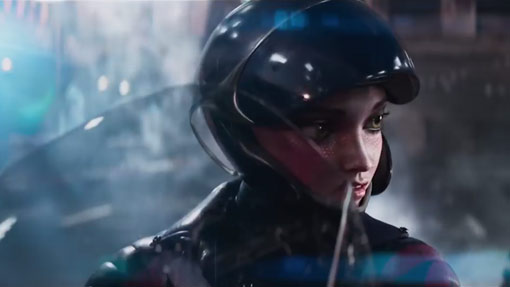
Artemis (Olivia Cooke)
Unlike her novel’s counterpart, the character of Artemis is given over to being more of a ‘person’ here, and less of a ‘prize.’ Both her human counterpart and avatar are given more time and purpose in helping move the story along, but in regards to fully making her and Wade into a couple, it just didn’t work for me (then again, this could have been Spielberg channeling the ‘meet cute’ romances of 80’s films).
I’ve often believed that when it comes to Spielberg choosing his projects, he does so based on certain world events. Current events definitely feel like the world of 2045 in RP1 is possible: one in which high unemployment and crippling debt are the norm, and the majority of transactions are made digitally, with drones making all of our deliveries.
There are also some topics regarding the ‘disconnect’ many feel even when ‘connected’ through digital means, as well as how protecting your identity can be detrimental to your well-being.
Much like his work with The BFG, Spielberg’s work on RP1 ping-pongs between a virtual world, and a real one. CG character believability has been improving over the years, and for much of the film, I was surprised how focused I was on the motion-captured characters, and stopped looking for ‘bugs in the system.’

L to R: Sho (Philip Zao), Aech (Lena Waithe), Parzival (Tye Sheridan), The Caretaker, Artemis (Olivia Cooke), Daito (Win Morisaki)
Of course, one thing that many will be looking forward to, will be the character-heavy scenes within the Oasis. While some references are called out, the film fortunately doesn’t stop for every single little moment, treating most of the licensed cameos, in the same way Disney’s Wreck-it-Ralph did. I will admit that I did have some ‘fanboy’ moments watching the film, but knew I had to judge the film on it’s merits, and not just on stuff I recognized.
Story-wise, the film thrusts us into it’s world pretty quickly, before allowing us some time to catch our breath in the second act. It feels like the story starts getting unwieldly in it’s third act, as Spielberg is almost in a mad dash to keep the action going, and resolve a number of plot threads. He almost ends up pulling a Return of the King with all that is going on, which made me pine for the simplicity (and editing) of a George Lucas Star Wars film ending.
While I was also very excited to hear that composer Alan Silvestri was on board, I felt his contributions to the film were sadly overshadowed too often by the 80’s soundtrack that was thrown at us. Even with the full force of the IMAX sound system around me during my screening, the only time Silvestri’s music really stuck out for me, was (sadly) during the closing credits.
Ready Player One overall, feels like it has a hard time finding it’s equilibrium. Spielberg struggles to bring out more of the novel’s cautionary vision of the future to viewers, but ends up sacrificing some of that message in favor of Wade and his friends, striving to ‘save the world’ in their own way.
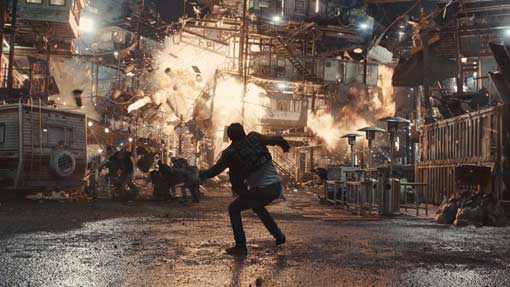
Even so, I do wonder if the struggle of the young people in the film, fighting ‘a war for control of the future,’ may in some way inspire the young people in our own reality, who are struggling against forces that seem insurmountable as well.
Final Grade: B
__________
Movie Musings: Remembering ‘Mars Attacks,’ 20 years later

The year: 1996.
One day, a strange-looking species of extra-terrestrials, descended from the heavens, and quickly laid waste to our planet. Humanity attempted to fight back, but even their strongest weapons proved to be of no use. And then, in a moment of sheer absurdity, a secret weapon was found. The most unexpected thing of all, managed to take down the alien scum, and save the human race.
No, its not Independence Day. It’s Mars Attacks!
After a Summer dominated by Roland Emmerich and Dean Devlin’s Patriotic alien invasion film, Winter found director Tim Burton, attempting to do his own thing with aliens. Burton had provided Warner Brothers with hits such as Beetlejuice and Batman, and to them, it probably seemed a no-brainer, to allow Tim to
__________
Nothing “Topps” Nostalgia
Tim Burton has often looked to the past for some of his artistic inspiration, and that was just whaat he did with Mars Attacks.
While some of it’s sensibilities would link it to the ‘invaders from space’ films like Earth vs The Flying Saucers, the bulk of it’s inspiration, would come from…bubble-gum cards?
The Topps Company released the Mars Attacks card series in 1962, depicting a number of skull-faced, big-brained invaders from Mars, destroying cities, vaporizing animals, and plenty more un-pc machinations.
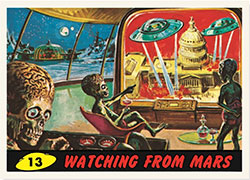
Keep in mind of course, that these images were on bubble-gum cards, geared towards kids!
The subject matter caused an outcry, and the cards were quickly discontinued…however, the memory of their imagery lingered, and many of the materials based on them (due to their limited run), became collector’s items in later years.
As those children became adults, Topps reprinted some of the cards, and quickly found adult collectors eager for more.
The 1996 film that Burton made, brought about a larger resurgence in the Mars Attacks property. Along with film-based material, a newer interpretation of the aliens were created by Topps, and new cards and comic books were produced, along with figures, and crossovers with other comics series (such as Judge Dredd, and…Transformers!?).
__________
A (Monster) Mash-up of Genres
Of course, one can’t just spend 1 1/2 hours showing aliens blowing up stuff on the big screen. Mars Attacks needed a story to tie together the carnage. But where was one to turn for story inspiration?
How about, the films of Irwin Allen?
In the 1970’s, Allen gained notable fame for bringing together large casts of name-actors, and thrusting them into the center of major disasters. Out of this filmmaking came hits like The Poiseidon Adventure, The Towering Inferno, and many more.
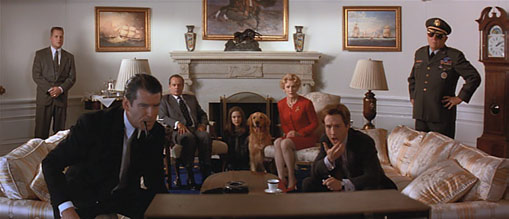
An example of the film’s big-name cast. From Left to Right: Brian Haley, Pierce Brosnan, Jack Nicholson, Natalie Portman, Glenn Close, Martin Short, Rod Steiger
That seems to be what was put together for Mars Attacks, though word was, the film was going to be bigger than what it eventually became. Originally, the martian attack would have taken place around the globe, and involved a lead cast, of over 5 dozen characters! The original script would even be tagged with a budget of $260 million (which was enormous by 90’s standards!).
Story and Screenwriter Jonathan Gems, credited Burton (who was not given a writing credit) for honing in the story, focusing it solely in the United States, and paring down the characters, to a ‘measly’ 23 leads.
There are even a few jabs at that greatest of all war-time comedies, Dr Strangelove or: How I Learned to Stop Worrying and Love the Bomb. This is evident in one of the alien’s translated words meaning ‘bodily fluids,’ and President Dale having an elaborate War Room. Plus, much like how actor Peter Sellers played several roles in Strangelove, Jack Nicholson does the same in Attacks, playing straight-laced President James Dale, and sleazy Vegas developer, Art Land.
The production design also plays around with the time-period. Though it is meant to be modern-day America, many of the settings we see are decidedly retro. The scenes in Kansas definitely feel like Richie Norris (Lukas Haas) and his family, are stuck in a time-warp, and whenever we see Police officers or Military personnel, their uniforms and vehicles are decidedly retro.
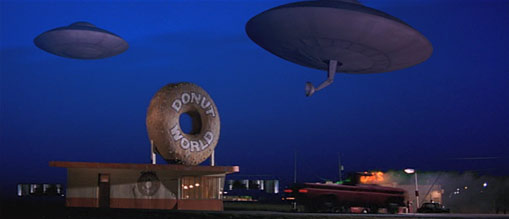
Burton has dabbled in combining generational stylings in other films, such as Edward Scissorhands, and Charlie and the Chocolate Factory. With Mars Attacks, it feels like he really opened the door wide, with several decades worth of inspirational imagery.
__________
Character Caricatures
Just like those Irwin Allen films, Mars Attacks’ advertising boasted a veritable who’s-who of casting. Such big names included Jack Nicholson, Glenn Close, Annette Bening, Pierce Brosnan, and…Tom Jones!?
The film also has some fun with its character types, with Paul Winfield playing the low-key General Casey, who would act as counterpoint to the more bombastic General Decker, played with over-the-top zeal by Rod Steiger.
Along with the more seasoned actors, the film also brought on some young blood, with Natalie Portman portraying Presidential Daughter Taffy Dale. There was also Lukas Haas as Richie Norris, the young man stuck in the middle-of-nowhere America (aka Kansas), with his trailer park family (played by Joe Don Baker, O-Lan Jones, and Jack Black).
One actor who I remember being surprised to see again, was Sylvia Sidney. First introduced to me as the Maitland’s caseworker Juno in Beetlejuice, Sidney plays the senile Grandma Norris, who ends up finding the secret weapon to saving the human race. She also gets one of the best lines in the film.
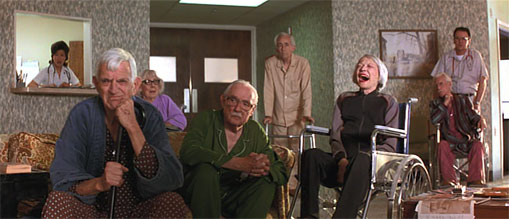
“They blew up Congress!”
The film would be Sidney’s last film appearance, as she would pass away in 1999.
__________
Pushing into the Digital Frontier
Tim Burton has often had a strong affinity for the effects and animation work of the past.
When it came to pulling off the craziness of faces contorting in a grotesque fashion, or bringing his twisted Christmas fables to life, he often opted for stop-motion puppetry.
Burton was all set to do the same with Mars Attacks, but that plan quickly fell by the wayside, as Warner Brothers wrestled with keeping the film’s budget under control.
The solution, was to have the full-motion martians realized in the same way as Steven Spielberg Jurassic Park dinosaurs: with an assist from Lucasfilm’s visual effects company, industrial Light and Magic.
Though it may be seen as a travesty to some, I still like what ILM brought to the table. Making the martians digital creatures, can be seen as another stepping-stone in their development of the technology (they had already started doing ‘character animation with the films Casper, and Dragonheart).
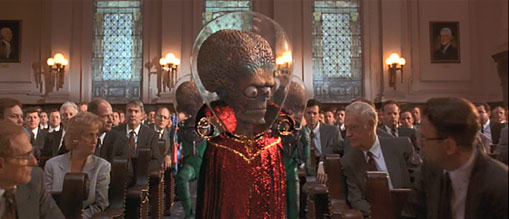
Creating the martians in the computer, allowed them to be rendered with reflections and lighting, to make them actually seem a part of the real-life scenery. Of course, the animators also added some ‘staccato’ movements, giving the characters a hint of their stop-motion ‘heritage.’
Of course, ILM can’t take all the effects credit for the film. Warner Brothers also added an assist, with their in-company group, Warner Digital Studios. WDS became responsible for the brunt of the global destruction in the film, as well as the myriad shots of the flying saucers, and death ray blasts.
It is fun to also see the filmmaking toe the line between advanced effects, and some that are meant to reference older films. Some shots are simple ones, where the camera doesn’t move, much like how a number of effects were achieved in older days. Plus, some animation cycles of the martians, are re-used multiple times.
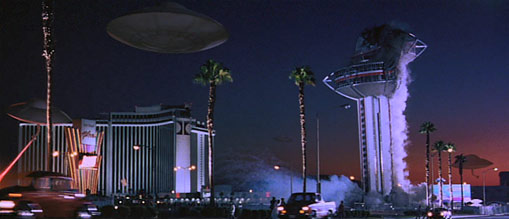
Of course, sometimes the real stuff is always good for a film. The filmmakers even used a real-life disaster, as destruction footage in the film. In 1995, The Landmark Hotel and Casino was destroyed by controlled demolition in Las Vegas. Footage of the event was captured and repurposed for the film, when the Martians destroy Art Land’s casino.
__________
In Conclusion
Sadly, in 1996, there was only room in America’s hearts for one alien invasion film…and that honor of most-beloved, civilization-destroying feel-good film, fell upon Independence Day.
Mars Attacks didn’t come close to making ID4′s box-office take, failing to fully recoup its budget and marketing costs.
Both films did share a multi-part story about an alien invasion, but whereas Emmerich’s film used coincidence and numerous references to Star Wars, Burton’s vision was a bit of a downer. Some claimed the film was WB’s attempts to ride ID4’s coattails, but in truth, the film had been in development before Emmerich ever pitched his film idea to Twentieth Century Fox.
It’s dark comedy tone may also have turned away a number of people. There wasn’t anyone quite as charismatic as Will Smith in the film, and a large portion of the all-star cast, would find themselves turned into colored skeletons (or disintegrated) by the martian weaponry.
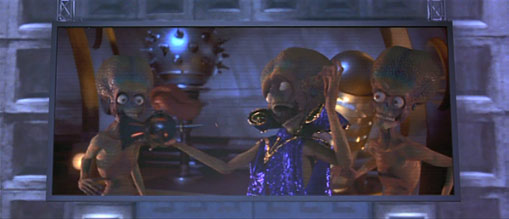
Even the Martians’ end-game was never discussed. At the most, it seemed like they were little more than bored teenagers, and just decided to invade the Earth for kicks and giggles.
The film could also be considered ‘cruel’ by today’s standards, as just like in one of the Topps cards, Burton decimates a few animals (the First Lady even lobs the skull of the deceased family dog, at a martian intruder!).
I will admit that I don’t hold Mars Attacks up as a true Burton masterpiece, but it is a film that shows his sensibilities, and love for both the Topps cards the film is based off of, and a film that attempts to revel in the irreverence of the 1950’s B-movies, and the disaster films of the 1970’s.
Plus, one of the more fun moments, is Jack Nicholson’s speech, given to the Martian Leader. It isn’t as well-remembered as Bill Pullman’s from ID4, but the timbre and the accompanying music, make it quite entertaining to hear.
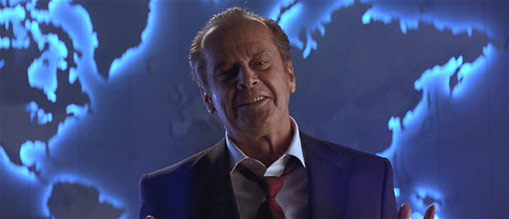
“Why can’t we all just…get along?”
My (personal) fondness for the film, also ties into my high school days of marching band. It was my band director who helped ‘introduce’ me to Danny Elfman’s music, and opened my eyes further to who/what Tim Burton was (putting to rest a lot of the strangeness that seemed frightening to my suburban-raised mind).
I recall picking up the soundtrack to Mars Attacks in the winter of 1996, and loaning it to my director to listen to (at first, he didn’t even think Elfman had done the music for the film!). Less than a year later, we were playing the film’s theme as part of our Marching Band’s Danny Elfman-themed show (Music for a Darkened Theater, Vol 3). Our director even went all-out, costuming one of our band members as the Martian Leader, who ‘vaporized’ several members of the band as the song played (my sister ended up being tagged as one of the ‘victims,’ collapsing to the ground in a vaporizing puff of ‘flour’).
It almost feels like the 1990’s were the perfect ‘breeding ground’ for such a picture. If the film had been made in the early 2000’s, it probably would have seen it’s subject matter depicted in a ‘heavier’ way, much like how Steven Spielberg re-imagined H.G. Wells’ The War of the Worlds, in a post 9/11 world. If anything, a post 9/11 Mars Attacks, would probably have been less faithful to the Topps cards, and treated more as a realistic war film.
As it stands now, it is one of a number of those 90’s films, that definitely feels like a product of it’s time.
Movie Review: Midnight Special

(Rated PG-13 for some violence and action)
These days, while a lot of people have been eagerly anticipating seeing Warner Brothers’ big Spring release (and ‘launch’ film) Batman vs Superman, I found myself just steering clear of the multiplexes.
In the last few weeks, I began hearing word about a film called Midnight Special. The most I got from a number of tweets and information online, was that it was definitely something special…and according to many reviewers, it was recommended to see it with as little knowledge as possible.
This type of recommendation had also been suggested for other films I had seen, like It Follows, The Witch, and 10 Cloverfield Lane.
And so, I took a leap of faith as I had done with those other films, and stepped into the unknown, of writer/director Jeff Nichols’ latest work.
__________
The film opens with two men named Roy (Michael Shannon), and Lucas (Joel Edgarton), driving across Texas in a beat-up Chevelle. A young boy wearing swimming goggles named Alton (Jaeden Lieberher), sits in the backseat, reading comic books.
As they drive across the state, a string of FBI agents descend on a ranch and its inhabitants, taking them somewhere for questioning. One of the persons doing the questioning, is a man named Sevier (Adam Driver).
Alton’s name comes up several times in Sevier’s sessions, and he soon begins to develop questions about the boy as well.
__________
If the summary above seems rather vague, it was because I meant to keep it so.
From the start of Special, writer/director Jeff Nichols throws you into the story with very little information. Much like It Follows, the film is dependent on the viewer using their brain, and at times, drawing their own conclusions.
For those who are well-versed in the films of Steven Spielberg (such as myself), one might also find themselves getting quite a few vibes coming off the film, that will make your “Spielberg-senses” tingle. How crazy are they?…well, I had to excise at least 3 paragraphs from this review about my thoughts on that.
Though where some of Spielberg’s more memorable films might put the camera at Alton’s point-of-view, Nichols holds our focus moreso on the adults.
This was one of the first times I had seen Michael Shannon in anything other than Man of Steel, and I wasn’t sure if I could buy him as ‘a regular guy.’ I was surprised that within 5 minutes, I was able to put aside thoughts of General Zod. There is definitely something going on behind his eyes in this film, and that helps keep his largely quiet demeanor all the more interesting.
Joel Edgarton’s role here is to support Shannon’s character, and the mystery of just who is and how he fits into the story, takes some rather surprising twists and turns.
One of the minor but more memorable characters in the film is Sevier, an FBI agent who figures into the overall story. Of course, after Adam Driver’s turn as Kylo Ren (and Matt, the radar technician), it might be hard to take him seriously in this role…then again, Driver’s character provides some of the few laughs that can be found in this film.
In a strange way, the film is very much a family film, but not like the more sterile, PG-rated fare one knows today. It almost taps into some of the more ‘serious’ tones of 30 years ago, when there wasn’t such a high factor on not scaring the younger ones in the audience.
In recent years, we’ve seen how some filmmakers have tried to tap into the zeitgeist of memorable films of yesteryear (such as Super 8). Here, Nichols actually manages a balancing act that I almost considered impossible. His film manages to straddle the line, with one foot in the films we grew up with in the 70’s and 80’s, and one foot in the present, where many of us have become adults and parents with responsibilities, and new points-of-view when it comes to life.
I will admit when it comes to films containing mysteries, I felt let down by films like Tomorrowland and Prometheus. Those were big films that seemed to hoard more answers that would probably have allowed the audience to go along with much of their world-building, if they would have given us just a bit more content. Luckily, with the smaller format Nichols has with Special, there was less chance of that happening here.
The jigsaw puzzle layout of the film provides enough pieces and information to feel satisfying, but we never get the entire multi-piece puzzle solved, leaving us with plenty to ponder on the drive home.
In the last few years, I have also been surprised at discovering new composers when I find smaller films. In this case, David Wingo’s music is both ethereal, and moving in its minimalist stylings. His main theme definitely stands out, with its simple (and mysterious) piano melody, that sounds like a car driving off into the dark night, not sure just where the final destination is going to take you.
The crowd that wants all their answers spoon-fed to them will most likely grow agitated, but to those of you who want to give your brain and emotions a workout, Midnight Special is the little film that manages to be an experience that will make you wish we could see more films that do what this one does.
__________
Final Grade: B+ (Final Thoughts: “Midnight Special” feels like an enjoyable anomaly in the film world right now. It manages to put one foot in the past regarding films we may recall from Steven Spielberg and the 1980’s, but also plants a foot firmly in the realms of adulthood, and seeing the world from a perspective that might not be wholly comfortable. The actors within the film help drive its mystery forward, dropping small hints that never keep us from feeling like the film is being too covetous with its information. The film is one of the best-kept secrets in theaters at the moment, and I do hope more people will discover it as its limited release continues its slow roll-out across the country)
Audio Commentary Commentation: The Goonies
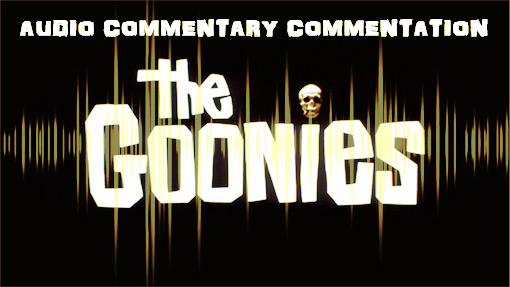
*With the rise of DVD’s in the late 1990’s, one feature many promised with the addition of Special Features, was audio commentaries. These would often contain dialogue from the film’s crew, or even film historians. In this category, I’ll discuss some of the audio commentary tracks that I feel are rather compelling, and end up being entertaining, in regards to the information provided, and what is being said.*
__________
Though his name had become synonymous with the words “Director” and “Genius,” Steven Spielberg slowly moved into a new arena of filmmaking in the mid-1980’s, when he adopted the “Executive Producer” moniker.
Under his production company Amblin Entertainment (named for the short film that got him his job at Universal Studios), Steven’s name soon headlined a number of pictures, with the tagline, “Steven Spielberg Presents.” Though the average person would assume that he had somehow directed another picture, in truth, he would moreso be there as a shepherd to the picture, throwing in a few ideas, and having a hand in the creative process.
1985 would be a big year for Amblin, when Back to the Future took the Summer by storm, becoming the biggest film of the year. However, a month before Marty McFly went back in time, another Amblin production had hit theaters: a family film by the name of The Goonies.
Based on a story by Spielberg, and directed by Richard Donner (Superman, Lethal Weapon), a misfit group of friends find a map that seems to promise pirate treasure right in their own backyard (aka Astoria, Oregon). With their stomping grounds threatened to be bulldozed for a new golf course, the friends set out to save their way of life, but soon find a couple of escaped fugitive and their tough-as-nails Mother, also wanting to get at the loot.
Though it didn’t take in as much as Back to the Future, The Goonies became the 9th highest-grossing film of 1985, with $61 million, which was quite good in those days, considering its budget was ‘only’ $19 million.
Over the years, Goonies gained quite a fan-following, and when it came time to convert it to DVD in 2001, some higher-ups at Warner Brothers actually had a great idea!
The studio had already reunited the former child actors from Willy Wonka and the Chocolate Factory to record an audio commentary for that film’s DVD release, and decided to apply the same TLC to The Goonies!.
Director Richard Donner was brought in, along with Sean Astin (Mikey), Josh Brolin (Brand), Corey Feldman (Mouth), Ke Huy Quan (Data), Jeff Cohen (Chunk), Kerri Green (Andy), and Martha Plimpton (Stef).

A promotional image of the cast and Richard Donner, taken on the day of the commentary recording.
The commentary track would be a little different than the Wonka one, as an alternate version of the film could be accessed, where the film at times would phase into a corner of the screen, to see the cast and director at the microphones in the studio, talking over the scene.
Of course, with over 8 people in the studio talking about a film, there’s bound to be a lot of stuff flying around. Though Corey Feldman seems to overpower so much of the conversation, there’s plenty of ‘rich stuff’ to be gleaned from the film.
Below are a few ‘choice comments’ that I thought I’d bring up. Don’t be afraid that I’ve spoiled everything. There’s plenty to discover on your own.
__________
During the course of the commentary, little asides are made to an alternate cut of the film that was never released. Some additional scenes included some gorillas, and even an octopus (which was mentioned by Data in the final cut near the end!), though noone has really deciphered what that much longer version would have been.
During the opening chase of the film, Sean Astin makes mention of a scene that was filmed, but not included in the final film.
Sean Astin: Do you guys remember the stunt we all got to go and watch, where they flipped the cop car on top of the boat?
Corey Feldman: No.
Martha Plimpton: Yes, I remember that.
Sean Astin: They drove the cop car off-they had a rig where the cop car goes-and it flips upside-down, and the guy gets out and he looks-you didn’t use that.
Richard Donner: No, we didn’t use that.
The scene would have taken place during the Fratelli’s car chase in the beginning, though surprisingly, footage of the stunt did make it into a Making-Of special produced at the time, as seen below.

__________
Jeff Cohen is one of the most entertaining persons on the commentary. He gives a few insights into his career as ‘a little fat kid’ in Hollywood, but also provides some interesting remembrances from the set, including the ever-famous ‘Truffle Shuffle.’
It was hard to choose something that wouldn’t give away some of the best stuff. One that came to mind, was the scene where Chunk is locked in a storage closet with a dead federal agent (played by stuntman Teddy Grossman).
Jeff Cohen: Now when we were doing some of the takes where the dead guy’s in the um, like this-
Richard Donner: Yeah.
Jeff Cohen: -Dick (Donner) said-you know, we’d improvise. He’d be like, “Smack him in the face, kid. Make sure he’s dead. Make sure he’s dead.”
So I’d be smacking him and smacking him and smacking him, and after 8 takes of smacking Teddy in the face, he finally- he-the dead body yelled, “Cut! The kid’s beating the crap out of me!”
Though getting whacked around by a little fat kid like Chunk probably wasn’t as bad as Teddy’s role as another victim, in Spielberg’s 1975 film Jaws. In that film, the shark overturns his character’s boat, and drags him under the water to his death!
Also as an aside, when he was a student at The University of California-Berkeley, Jeff Cohen ran for Class President, using the campaign slogan, “Chunk for President.” Naturally, he won.
__________
Of course, not all ‘war stories’ from the trenches of filmmaking are great. Some leave deep scars that last for years. Carrie Henn who played Newt in Aliens had a memorable line (“They mostly come out at night…mostly.”) that her friends would often alter in a jokey sort of way. The same thing happened to Kerri Green, during a sequence where Andy freaks out in the caves and starts babbling:
Kerri Green: This is my big dramatic moment. I got made fun of this for 15 years.
*Andy in the movie is babbling, “Don’t I have a beautiful body? Don’t I have a beautiful body?”*
Corey Feldman (mimicking Brand on-screen): You have a great body.
Kerri Green (referring to her character’s babbling): That one. That was the line.
Sean Astin: You were really worked up when you were doing that.
Kerri Green: 15 years, people are like, “Don’t I have a beautiful body? Don’t I have a beautiful body?”
Sometimes it’s fun when actors or actresses confess little things like that. Though this was recorded in 2000/2001, so one wonders if after Kerri aired her grievances, some people backed off from the mockery of her teenage cheerleader’s worryings.
__________
As the commentary continues, one can’t help but almost want to throttle Corey Feldman as he gives his two cents on every other moment in the film.
Though it seems in truth, he hasn’t changed all that much from when he was younger. During a scene in the wishing well where Stef and Mouth start to argue, Martha Plimpton shares a memory of an encounter with Feldman one day.
Martha Plimpton: Actually, what people don’t realize, is that at one point actually, Corey came to me in the school trailer, and I turned to him and I said, “What?”
And he said, “What?”
And proceeded to copy everything I said, for half an hour, until I became so enraged, that I jumped on top of him, and grabbed his head, and started smashing it against the floor. Meanwhile, he sat-lay there, laughing maniacally the entire time, making me even more infuriated, with Rhoda Fine (the on-set studio teacher) standing over us going: “You kids stop it! Don’t fight!”
Martha has a few interesting remembrances regarding the production, though this one, she really got the chance to just lay it all out on the table. It’s one of the few bits on the commentary, where no one interrupted her daring tale of Feldman-related Fury.
__________
The Goonies is definitely an entertaining product of the 1980’s, and I’m sure would rank in the Top 10 of many of the films with Spielberg’s Executive Producer credit on it. The film has had popularity in the last decade, with a couple different action figure lines, and yearly events in Astoria, Oregon for the film. These events have even brought forth some of the cast and crew to join in on the festivities.
When I first started collecting DVD’s, this film’s release was one of my favorites. Though not as chock-full of what I would hope for (no word on that original cut that had gorillas involved!), it gave us plenty of extra features, including Cyndi Lauper’s The Goonies R Good Enough music video, and some promotional materials made for the film. Though of all the materials, this commentary is one of the highlights. It definitely makes me wish some other films could have such an entertaining group commentary.
Currently, the special commentary presentation has been in each version of the DVD and Blu-Ray releases, so you won’t have to shell out $35 for some super-special-edition.
I feel every fan of The Goonies should sit down and watch this commentary. Sadly, we can’t do much about Corey Feldman’s constant mouthing off, but in the end, I’m sure you’ll be pleasantly surprised at what the majority of the cast and Richard Donner have to say.
Movie Review: Mad Max – Fury Road

(Rated R for intense sequences of violence throughout, and for disturbing images)
I’ll just get this out of the way first: it’s been a long, long time since I’ve seen any of the original Mad Max films. The last time I can recall seeing one, was stumbling into a Sci-Fi marathon at the Music Box Theatre 5-7 years ago, and catching the last half of the first Mad Max film
So, as one might expect, I went into Mad Max: Fury Road without any preconceptions, other than Max being a loner, tooling around in his supercharged Ford Falcon.

In this latest iteration, Tom Hardy takes on the role of Max Rockatansky, a man running away from a tragic past, who is soon caught by a group of War Boys working for the warlord, Immortan Joe (Hugh Keays-Byrne).
Even with Hardy getting top-billing, I feel that many will be moreso captivated by Charlize Theron’s Imperator Furiosa. It is Imperator that gets the ball rolling in this story, when she takes Immortan’s iconic tanker truck off-course, with a daring plan of her own.

It doesn’t take long for Max to get caught up in Imperator’s affairs, and what forms is an unlikely truce…but in a way that is very rarely ever seen onscreen. There’s no romantic spark, no “my mental scars are worse than yours” moments…pretty soon, it all boils down to one thing: “getting the job done!”
This reminded me very much of a similar mentality of films like Terminator 2: Judgement Day, and Children of Men. Both of those films deal with characters that are in a world that seems to shun hope, yet they desperately cling to the notion that it could very well exist, pushing themselves to their limits to achieve a goal.
Another strength I liked about the story, was that it never really felt like anyone overstayed their welcome on camera. The characters and their roles move through the story in a very efficient way, always trying to stay one-step ahead of Max and Imperator’s pursuers…whom director George Miller often captures as an ominous presence off in the distance. We even get to see some of Max’s trauma manifest itself, but just what happened to him is never fully explained.
Speaking of Max, I did like how even though his name is on the title, he is not constantly the center of attention. In a sense, his role in this film reminded me of Jack Sparrow in the first Pirates of the Caribbean: a character who through a series of circumstances, ends up falling into an adventure, of which he himself manages to tie much of it together.
That’s not to say the film is incredibly serious. After all, how serious can your movie really be if one semi truck is rigged with a 20 foot speaker array, with a guy playing a flame-throwing guitar in front of it?

I will admit that one of my ‘poisons’ when it comes to some films, are cool-looking vehicles. Many have pressed my buttons ever since I was a child (along with vehicular mayhem), and what was done here with numerous vehicles is rather compelling. One that is rather eye-catching, has the body of a Chrysler Valiant, welded atop some heavy-duty tank treads.
The chase scenes in this film are definitely a highlight, and I came away from watching this film, greatly impressed at the stunt-work on display. Needless to say, when 100+ names filled the screen under “stunts” during the credits, I applauded. And, even when there are stunts that have to be achieved by visual effects, it was hard to tell most of the time.
In regards to the film’s music, the score for the piece is provided by Tom Holkenborg, aka Junkie XL. That driving rhythm you’ve heard in the latest trailers? That’s part of Junkie’s score, and he manages to capture the gamut of emotions so well within Fury Road! Everything from the quieter moments, to the heart-pounding scenes of vehicles tearing across the plains. In fact, much of this review was written with the soundtrack blaring from my speakers.
Though I have been pretty positive about Fury Road, the film is far from perfect. There are some times where it feels like some of the chase and fight scenes get a little too long, and I could sense the audience getting restless at times.

In regards to George Miller’s filmography, one can easily see that in many of his works, he can’t just give you a straight-forward story of good-vs-evil. He does like to layer his work with multiple themes, and Fury Road can get a little overloaded in places…though luckily, Miller doesn’t muck up his films as thickly as director Gore Verbinski likes to do.
At the preview screening I attended, the film was projected in 3D. While it did highlight some scenes like flares going off in the sky, and the amazing dust storm sequence, I really didn’t see much of a need to use it for this film. In the end, there was one gratuitous 3D shot that did make me chuckle.
Even so, I have to give Miller and his guys kudos for actually filming action scenes like many of us remember: shot in a way where we actually know what we’re looking at, and who is where, doing what! The camera work definitely feels like we’ve gone back 30 years into the past, where the filmmakers at least attempted to put some control over where to focus our attention. At least it helped the 3D shots to actually feel less like they composited flying colored blobs on the screen. The cinematography also takes its time, providing some nice establishing shots.

I held out some hope that Mad Max: Fury Road would be entertaining, and it definitely surprised me. It didn’t get gratuitous for the sake of gratuity (like many R-rated films). Even with possible hints of nudity, it’s rather amazing that Miller doesn’t give in to temptation. I did enjoy that he showed restraint in some areas, even if he may have gone a tad long in others.
This is one of those films that did awaken a hunger deep within me as well: a hunger for as much making-of material as possible! I can only hope that George Miller can convince Warner Brothers to jam-pack the home video release with all sorts of material on the vehicles, character profiles, along with the stunt work…which I feel could probably warrant an hour-long special of its own!
Final Grade: B+ (Final Thoughts: George Miller’s resurrection of Mad Max, brings about an apocalyptic story betwixt hope, and madness. It introduces a strong new character in Charlize Theron’s Furiosa, and gives us an action-packed film that has a lot to say, but may be trying a little too hard at times to say everything it wants to )
DVD Set Review: Tiny Toon Adventures – Looney Links!

And then…it was over…well, not quite over, but as over as one can expect from-
Oh, alright. With the recent release of the Looney Links DVD set, the gang of Tiny Toon Adventures now have (almost) all their half-hour antics on DVD, time-capsuling an era that signaled the resurgence of Warner Brothers as an animation powerhouse, thanks to the likes of executive producer, Steven Spielberg. (note: the keyword in that previous sentence, was ‘almost’).
However, the hope that many had that the series would be given a dignified exit on DVD, hasn’t come to pass.
As I noted in my review of the previous DVD release, Crazy Crew Rescues, it seemed that Warner Brothers was only interested in releasing this set just to complete the previous volumes that had come out almost 4 years prior. The Looney Links set also suffers from the same half-@$$ed presentation, of minimal disc art, and DVD menus so sparse, one would have assumed this thing was put together by bootleggers (heck, I think the stuff the bootleggers at comic conventions put together would probably be a step up!).
The most glaring problem in this latest release, has to do with whoever was in charge of ‘quality control.’ It concerns an episode on disc 2, titled Weekday Afternoon Live. Halfway through the episode, it suddenly cuts to footage from another episode, titled Toon TV. As someone who probably watched these episodes several dozen times, it definitely threw a wrench in my viewing.
As of this writing, a small trickle of complaints is happening on the Internet. I’m scheduled to send my copy back to WB, and will update this review when (and if) my replacement set comes in, along with any updated information regarding the company’s intent to rectify the situation.
While most of the episodes are good/passable, there’s a couple that stand out in my mind all these years later:

Toons Take Over – after growing tired with their daily, monotonous comedic antics on Tiny Toons, Buster, Babs, and Plucky have had it. Taking a page from most Hollywood types being typecast, they decided to write/produce/direct/star in their own cartoon.

The Horror of Slumber Party Mountain – Elmyra gets her ‘inner-Elvira’ on, hosting a screening of The Horror of Slumber Party Mountain, in which Babs, Shirley the Loon, and Fifi le Fume’s slumber party in the scary woods is ruined by Buster, Plucky, and Hamton. However, they are soon to discover something lurking in the darkness.
Another notable segment deals with one more remembrance by Plucky Duck, as we get Baby Plucky being taken to play ‘Minister Golf’ by his Dad. Hilarity ensues showing the trials and tribulations of parenthood, but Baby Plucky’s swan-song isn’t as good as his previous two appearances.

Visually, I loved the gags in the episode titled, The Return of Batduck. Plucky attempts to get Tim Burton to cast him in the next Batman film (this episode was made in 1992), and the episode is chock full of visual gags based on Burton’s work. Even the music of the episode reflects Danny Elfman’s sensibilities at times. There’s even a rather dated gag showing Sean Young crazily trying to get Tim to consider her to play Catwoman (note: that gag is based on a true incident involving Young).
One would hope the series would have gone out in style with its cast. Instead, the series ended with the rather mediocre, It’s A Wonderful Tiny Toons Christmas Special. The story just doesn’t feel ‘all there,’ but what really will stand out for viewers, is Buster Bunny’s voice (even I was puzzled when I heard it in 1992).
Apparently, Charles Adler (who voiced Buster Bunny throughout much of the series) had creative differences with some of the staff, and resigned from his part as the series drew to a close (for more information on this, please refer to the following interview with Tom Ruegger).
In the end, Looney Links is one of the first DVD sets I’ve reviewed that I just can’t bring myself to recommend. It’s like trying to put your hand in a crocodile’s mouth: you do so at your own risk. This is given the fact that the second disc in the set seems to be processed incorrectly, and we don’t know how many ‘bad discs’ have been sent out, or what the spread of WB Home Entertainment’s plans will be to rectify the situation.
For now, heed my words…you have been warned.
*UPDATE 7/6/13* – Well, I received a package back from Warner Bros today, with a note claiming they have included a replacement disc. After checking out the episode Weekday Afternoon Live again, I found that this replacement disc also had the same issues as my previous one. As it stands, I’m waiting to hear about what the next course of action WB will take regarding this.
*UPDATE 7/24/13* – Third disc’s the charm, apparently. After I emailed Warner Bros after the last disc I received, they acknowledged that there was an error in the process, and that I’d be sent a replacement asap. The disc arrived the other day, and Weekday Afternoon Live is now playing in all its glory.
At this point, I can’t be sure if the company has recalled the Looney Links DVD sets that were sent out or not. But, I would like to give a little PSA to those of you who buy or have bought this set, so you can be sure your disc is right.

This is the image 12 minutes, and 23 seconds into the episode, Weekday Afternoon Live. After it fades to black, watch for the next image (which should be one of the two following images).
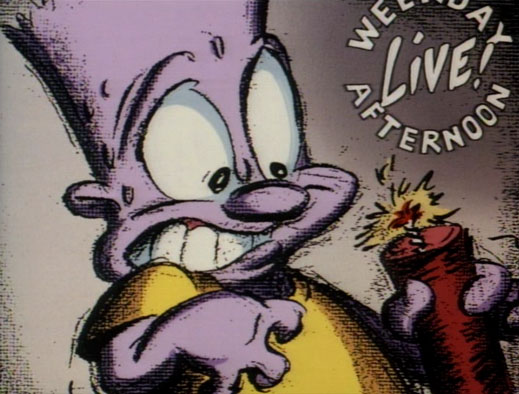
If the next image is this (looking like the previous one, just cropped closer), then your copy is as it should be.
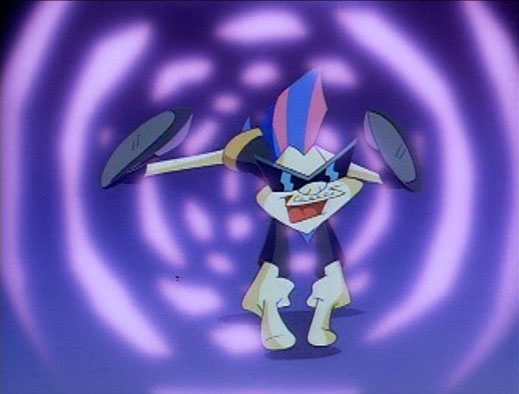
If it is followed by this image (from the episode “Toon TV”) , contact Warner Bros to get a replacement disc.
As stated above, this lapse in quality by Warner Bros definitely makes me wary regarding recommending the set. I’ve decided to include the above information to help many fans of Tiny Toon Adventures, in hopes that if you do purchase Looney Links, your episode collection is as perfect as possible.






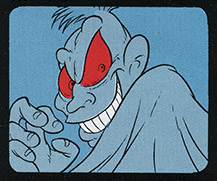 Known as “The Toon of a Thousand Faces,” Von Rotten was largely known for portraying all manner of villains in early cartoons. However, an accident on the set of a propaganda cartoon sent Von Rotten to the hospital. When he came out, many noticed that he would seldom drop the villainous personas he’d portray. As well, his eyes had taken on a reddish hue, which he soon hid behind dark glasses.
Known as “The Toon of a Thousand Faces,” Von Rotten was largely known for portraying all manner of villains in early cartoons. However, an accident on the set of a propaganda cartoon sent Von Rotten to the hospital. When he came out, many noticed that he would seldom drop the villainous personas he’d portray. As well, his eyes had taken on a reddish hue, which he soon hid behind dark glasses. The three then head to Doom’s mansion, and place the cel on the Multiplane Camera. Through the use of the camera, and a ‘freak electrical storm’ (shades of Frankenstein), Doom is resurrected! With his memory coming back to him, Doom is bent on revenge against Roger and Eddie Valiant. His first thoughts are to kill the wabbit, but then decides on another course of action.
The three then head to Doom’s mansion, and place the cel on the Multiplane Camera. Through the use of the camera, and a ‘freak electrical storm’ (shades of Frankenstein), Doom is resurrected! With his memory coming back to him, Doom is bent on revenge against Roger and Eddie Valiant. His first thoughts are to kill the wabbit, but then decides on another course of action. Eddie soon meets C.B., who does resemble his deceased brother, except for the dark shades on his face. C.B. explains how he intends to put the studio back into production, though using a more limited-style of animation to save on costs. C.B. wants Roger back as one of the studio’s main attractions, but wants Eddie to investigate if Roger is okay to be rehired. It seems odd that Eddie would seem fit to re-investigate a rabbit he is now friends with, but then again, C.B. is offering him $500 for his report. As expected, Roger’s clean, and C.B. calls him in. This works out in Roger’s favor, as he hasn’t done any work since the studio originally shut down.
Eddie soon meets C.B., who does resemble his deceased brother, except for the dark shades on his face. C.B. explains how he intends to put the studio back into production, though using a more limited-style of animation to save on costs. C.B. wants Roger back as one of the studio’s main attractions, but wants Eddie to investigate if Roger is okay to be rehired. It seems odd that Eddie would seem fit to re-investigate a rabbit he is now friends with, but then again, C.B. is offering him $500 for his report. As expected, Roger’s clean, and C.B. calls him in. This works out in Roger’s favor, as he hasn’t done any work since the studio originally shut down. Roger eagerly accepts C.B.’s job offer, but is shocked when on the first day of production, C.B. claims that Roger’s fully-animated stylings are too animated, and over-the-top. Roger struggles to tone down his animation style (see right), but finds he can’t ‘simplify’ what he’s doing. This leads to C.B. terminating Roger’s contract, and kicking him out into the street.
Roger eagerly accepts C.B.’s job offer, but is shocked when on the first day of production, C.B. claims that Roger’s fully-animated stylings are too animated, and over-the-top. Roger struggles to tone down his animation style (see right), but finds he can’t ‘simplify’ what he’s doing. This leads to C.B. terminating Roger’s contract, and kicking him out into the street. Going to 2719 Hyperion Ave, Eddie manages to get past the weasel-guard out front, and goes to the small office of the company’s President, Mr Mood. Entering the office, he finds C.B. Maroon, sitting behind the desk. Eddie questions why Maroon would create another company to buy up one he already owns, as Maroon’s claims that he doesn’t…but will very soon. As his movements become wilder, Maroon reveals himself to be Judge Doom in disguise! He then tells how he intends to use the development company to purchase the studio, and raze it once the sale is finalized. The destruction of the studio he feels, will end Roger’s career, as well as many other toons’ as well.
Going to 2719 Hyperion Ave, Eddie manages to get past the weasel-guard out front, and goes to the small office of the company’s President, Mr Mood. Entering the office, he finds C.B. Maroon, sitting behind the desk. Eddie questions why Maroon would create another company to buy up one he already owns, as Maroon’s claims that he doesn’t…but will very soon. As his movements become wilder, Maroon reveals himself to be Judge Doom in disguise! He then tells how he intends to use the development company to purchase the studio, and raze it once the sale is finalized. The destruction of the studio he feels, will end Roger’s career, as well as many other toons’ as well. It is then that Eddie pulls out a cartoon squirt gun, spraying Doom and the weasels. The group simply assumes Valiant is playing some kind of joke…only for Eddie to reveal that what they were squirted with, was Dip (of which he found a barrel in the film vault where he and C.B. were kept hostage)! The weasels and Doom then melt before everyone’s eyes, trickling down the gutter of a nearby drain.
It is then that Eddie pulls out a cartoon squirt gun, spraying Doom and the weasels. The group simply assumes Valiant is playing some kind of joke…only for Eddie to reveal that what they were squirted with, was Dip (of which he found a barrel in the film vault where he and C.B. were kept hostage)! The weasels and Doom then melt before everyone’s eyes, trickling down the gutter of a nearby drain. As well, Foster puts in an homage to one film that it seems every other animator or film fan homages sooner or later: Orson Welles’ Citizen Kane. This is seen in how the newsreel footage is put together (called Toons on the March, a parody of the newsreel titled News on the March in Kane). Though a most-telling scene, is when the weasels make their way to Von Rotten Manor, its towering silhouette and single-lit room, harkens back to the opening image of Welles’ film.
As well, Foster puts in an homage to one film that it seems every other animator or film fan homages sooner or later: Orson Welles’ Citizen Kane. This is seen in how the newsreel footage is put together (called Toons on the March, a parody of the newsreel titled News on the March in Kane). Though a most-telling scene, is when the weasels make their way to Von Rotten Manor, its towering silhouette and single-lit room, harkens back to the opening image of Welles’ film. Luckily, thanks to the great guys at FunkoPop, Doom has gotten a second likfe, as part of their vinyl figure line…and this time, with his ‘burning red eyes’ staring right at you!
Luckily, thanks to the great guys at FunkoPop, Doom has gotten a second likfe, as part of their vinyl figure line…and this time, with his ‘burning red eyes’ staring right at you!


 Admit it…you’d buy this, wouldn’t you?
Admit it…you’d buy this, wouldn’t you?

Audio Commentary Commentation: Willy Wonka and the Chocolate Factory
*With the rise of DVD’s in the late 1990’s, one feature many promised with the addition of Special Features, were audio commentaries. These would often contain dialogue from the film’s crew, or even film historians. In this category, I’ll discuss some of the audio commentary tracks that I feel are rather compelling, and end up being entertaining, in regards to the information provided, and what is being said.*
One item that quickly caught my attention with the rise of the DVD, were audio commentaries. However, while some studios went straight to the behind-the-scenes personnel like film directors and writers, someone at Warner Brothers actually had a really great idea when it came to repackaging some of their more ‘classic’ feature films.
One film that had grown to be a classic in their library, was Willy Wonka and the Chocolate Factory, based on the book Charlie and the Chocolate Factory by Roald Dahl.
For special features on the film’s DVD, a new documentary had been made, along with pulling together several other items from the archives…but when it came to audio commentary, the studio went the extra mile.
Though unable to secure Gene Wilder (Willy Wonka) or director Mel Stuart, they were able to get the actors who had played the five main kids in the film.
They were Peter Ostrum (Charlie Bucket), Michael Bollner (Augustus Gloop), Julie Dawn Cole (Veruca Salt), Denise Nickerson (Violet Beauregarde), and Paris Themmen (Mike TeeVee).
Plus, since the making of the film, it had been 30 years since they had all been in one place together!
The commentary rarely ever gets boring, and there’s a constant exchange of words and memories throughout. I thought I’d share a few of them here, for the film’s 45th anniversary.
__________
Boy-Crazy Girls
What’s funny as the commentary goes on, is hearing that both Denise Nickerson and Julie Dawn Cole, seemed a bit boy-crazy in their early teen days.
Very quickly, it’s mentioned how they had a crush on Peter Ostrum, oftentimes taking turns on who ‘got’ Peter during various days.
Other times, there was talk of how the runner-up would end up with the assistant director’s son, Bobby Rowe.
Bobby Rowe had a small part as a student named Peter, in Charlie’s class. Peter Ostrum as Charlie, is over his left shoulder.
One fun bit is where the girls try to draw Peter into the conversation about their pre-teen infatuation with him:
Denise Nickerson: Peter, does this just make you blush just thinking that two women were just fighting over you? But we did it so politely, and so civilly, didn’t we?
Julie Dawn Cole: Yeah, we did.
Denise Nickerson: Yeah, we understood, one day was mine, one day was yours (aka Julie’s), it was a good fight.
Peter: Moving right along…
__________
Perfectionist Tendencies
In several portions of the commentary, the actors discuss how the film’s director, Mel Stuart, could often be so exacting, that he would keep pushing and pushing on an actor until the scene was perfect.
Paris Themmen makes note of this in Mike Teevee’s introductory scene, in which he tells the news reporters that his Dad is going to get him a real six-shooter one day.
When Mike’s father proudly replies, “not til’ you’re twelve, son,” Paris shares a behind-the-scenes fact:
Paris Themmen: Ok, great line, one of the big laughs, I’ve seen it in theatres and everybody laughs at that line…it took us at least 45 takes to get him to say that line right.
Denise Nickerson: Oh, my-
Paris Themmen: I’m sorry, I don’t know where the actor is now, I apologize, but, it was a combination of his read and things going wrong with the set and so forth, and, that was the take that just took a lot of takes.
__________
Not quite a type of wart…
For playing such a brat on-screen, Julie Dawn Cole was nothing like her character…in some respects. Though she wasn’t a stuck-up loud-mouth, she somehow managed to keep her everlasting gobstopper, as well as one of the film’s golden eggs (which were not meant to be taken!).
Of course, Julie also had her own ‘trial by fire,’ when it came to Veruca’s golden tresses:
Julie Dawn Cole: It was in the day, 30 years ago, when the main obsession was about split-ends, and every single shampoo product was about curing the split-ends. And we had a German makeup lady, who was obsessed with split-ends. And she used to twist my hair like into a tight rope, and then run a candle down it, and burn the split-ends off. And if you look during the movie, my hair shrinks, because it caught fire, several times!
A fun game is to see if one can see how short Julie’s hair is in certain scenes. The scene where she enters the factory, was her first day of shooting, and the day that it was at its longest.
__________
The Dangers of Chewing Gum
When it came to gum-chewing as Violet Beauregarde, Denise Nickerson was often seen on camera chewing away, before she eventually swelled up into a blueberry for her big scene.
During the commentary, a question arose regarding all that chewing:
Paris Themmen: Did your jaw ever get tired?
Denise Nickerson: I spent two months in the dentist’s chair when I got back.
Paris Themmen: Really?
Denise Nickerson: This was before sugar-less gum, so yes, I did spend a lot of time at the dentist.
Of course, a reminder of her role seeped back into the real world with Denise, when she returned to the US after filming:
Denise Nickerson: So, I’m sitting in my math class two days later in New York City, I went to Rhodes School, I’m on the fifth floor of a brownstone in New York City, and all the kids start looking at me, and pointing at me and snickering you know, and I’m like: “What? What?”
And my girlfriend looked at me and she says, “you’re turning blue!”
Well the makeup had started resurfacing through my pores, and only my neck, my face, and my hands were blue. Ladies room was on the second floor so needless to say that I flew down there, never got asked for a date in that school but uh, what can you do?
__________
Over the years, some child actors are often plucked out of obscurity, bask in the limelight for a bit, and then return to ‘the real world.’ That was the case with Peter Ostrum, who played Charlie Bucket. Though he was offered a multi-picture deal following the film, Peter’s family declined the offer.
Though the other four kids do get in trouble, Charlie was not as innocent as he was in Dahl’s book. Charlie does transgress into being a semi-bad kid when Grandpa Joe (played by Jack Albertson) convinces him they should try the fizzy-lifting drinks, and while he doesn’t meet a horrid demise, Ostrum does tell that the scene was anything-but-pleasant:
Peter Ostrum: Jack (Albertson) and I thought this was going to be great fun-
Julie Dawn Cole: And?
Peter Ostrum: and it wasn’t. We wore these leather, “girdles” is the only way I can describe them and, all your weight, is hanging, right on your crotch. Jack made reference that the music that should be played to this, should be from “The Nutcracker Suite.”
Peter shares quite a few other stories about Jack Albertson, who also showed them some of his old vaudeville routines during the production.
__________
Much like The Wizard of Oz, the film was not a hit upon its release, but through re-releases, television, and home video, the film quickly became a staple in the viewing diets of many young persons.
I wasn’t raised on live-action musicals as a child, though I did see it when I was 4, and then 6 years later when in 4th grade, when most of the class voted to see it as our pre-Christmas movie.
Much like Julie Dawn Cole had to work through her dislike of chocolate (true story!), I slowly came around to the film over the years, though still don’t hold it in quite as high regard as most people out there.
Even so, it isn’t without its charm, and its behind-the-scenes stories about how it was created, still entertain me to this day.